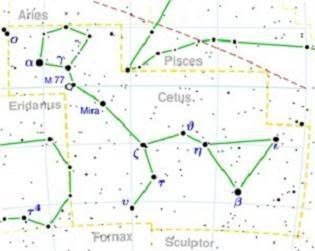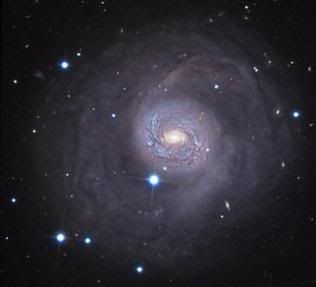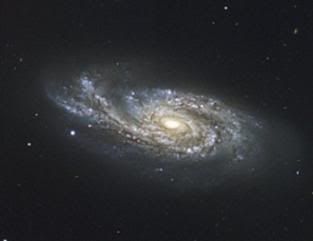Post by glactus on Feb 17, 2008 9:20:58 GMT

Cetus (the whale) is a constellation of the southern sky, in the region known as the Water, near other watery constellations like Aquarius, Pisces, and Eridanus.
This constellation's most notable star is Mira, the first variable star to be discovered. Over a period of 331.65 days it can reach a maximum magnitude as high as 2.0, one of the brightest in the sky and easily visible to the unaided eye. The nearest star is Luyten, 8.73 light years away.
Cetus lies far from the galactic plane, so many distant galaxies are visible, unobscured by dust from the Milky Way. Of these, the brightest is Messier 77 (NGC 1068), a 9th magnitude spiral galaxy. Another one of note is NGC 908 located at a distance of 65 million light-years.

M 77
M77 (NGC1068) is a small spiral galaxy that has a size of 7-by-6 arc minutes and 9th magnitude, and is one of the brightest in the constellation, distance is estimated about 47 million light years. You can recognize the figure of an ellipse with only small scopes, but the galaxy has no evoluted spirals, so detailed structures do not come visible with larger telescopes. M77 is one of the so-called Seyfert galaxies, which have strong radio sources.

NGC 908
NGC 908 is about 75, 000 light-years long, ( about 3/4 the size of the Milky Way) also clearly presents uneven and thick spiral arms, the one on the left appearing to go upwards, forming a kind of ribbon. These properties indicate that NGC 908 most probably suffered a close encounter with another galaxy, even though none is visible at present.
This spiral galaxy, is also-called the starburst galaxy, that is, a galaxy undergoing a phase where it spawns stars at a frantic rate. Clusters of young and massive stars can be seen in the spiral arms.

credits: Map and text
en.wikipedia.org/wiki/Cetus
Images: M77, NGC 908
cseligman.com/text/stars/messiergalaxies.htm


